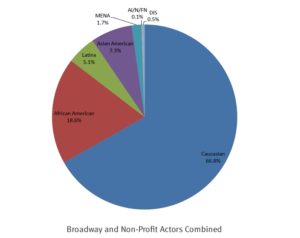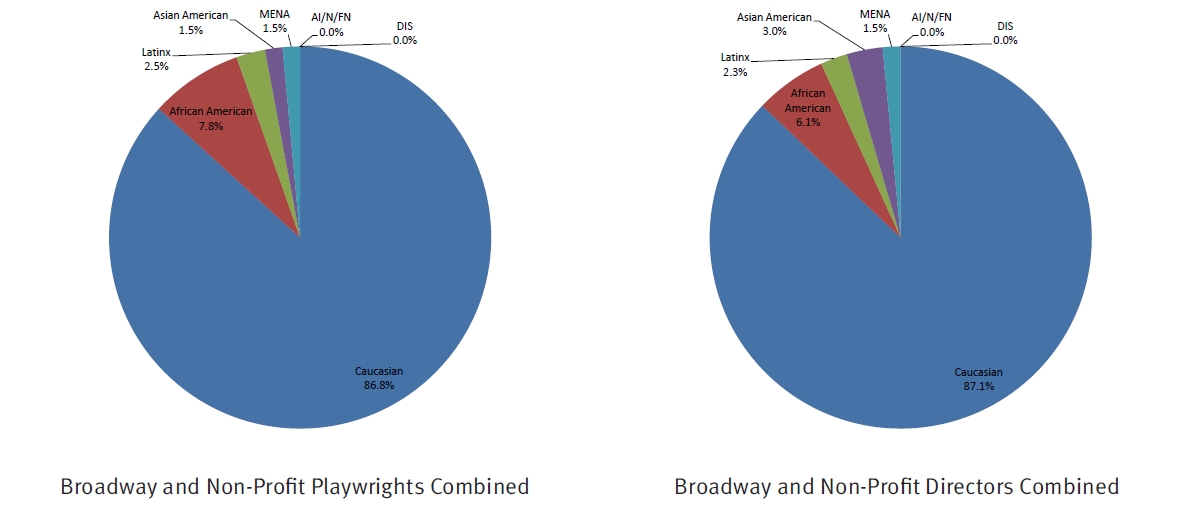NEW YORK CITY: The Asian American Performers Action Coalition (AAPAC) has released its latest demographics report for actors working on and Off-Broadway. The report tallies artists hired for the 2016-17 season. For the first time ever, AAPAC has also collected demographic data for playwrights and directors. They’ve found that 86.8 percent of all shows produced were by white playwrights and 87.1 percent of all directors hired were white.
In addition, they found that 33 percent of all available roles went to “minority actors” (defined as actors of color or those with a disability). That’s a drop from 35 percent in the previous season, though it’s up from the first season AAPAC began doing demographic reports, in the 2006-07, when minority actors were only hired for 15 percent of all available roles in New York City.
To Pun Bandhu, an actor and a member of the AAPAC steering committee, the new numbers, while not ideal, mark “a huge improvement from when we first started,” he says. “What’s been really great to see is how individual theatre companies have transformed their numbers and have really taken diversity to heart, not only because it’s now part of a national conversation, but there really do seem to be expectations—audiences now are looking for more diverse fare.”

This latest study measured 130 productions (and did not include shows that were still running from previous seasons). It was also broken down by Broadway and Off-Broadway representation. AAPAC believes that the slight drop in minority hiring, from 35 to 33 percent, is because 2016-17 followed the season of Hamilton and On Your Feet, which most consider “a record-breaking season for diversity on Broadway.”
Data show that in 2016-17, 42.8 percent of roles went to women and 0.2 percent went to non-binary actors. Breaking down the demographics, African American performers received 18.6 percent of roles, Asian Americans received 7.3 percent, Latinx folks received 5.1 percent, Middle Eastern/North African performers received 1.7 percent, Native Americans received 0.1 percent, and performers with disabilities received 0.5 percent. Minority actors also fared better Off-Broadway, receiving 37 percent of all roles Off-Broadway versus 29 percent of roles on Broadway.
And while the writers and directors hired also skewed white, the gender disparity was stark as well: 75.4 percent of all plays written were by men, and 68.2 percent of all directors were men (this lines up with similar numbers released by the League of Professional Theatre Women). AAPAC also counted composers and lyricists, which they included within the playwright tally.

Bandhu sees a correlation between the artists hired offstage and those hired onstage. “While our focus will always be on the performers, there’s a domino effect that happens when you hire creatives of color—they usually bring in design teams made up of people of color, they might hire more actors of color, and they might lean more towards non traditional casting,” he says.
By contrast, in New York City white people make up 44 percent of the population, which means that the report shows that white artists “continue to be the only ethnicity to over-represent compared to their respective population size in New York City.”
Since the release of the first AAPAC report in 2012, Bandhu has seen an openness on the part of artistic producers to have more conversations around increasing their talent pool. That openness makes him feel more optimistic that the demographic trends will only improve.
“I think the power in what we’re doing is we’re relying on the hard facts, and the numbers speak for themselves,” he says. “The conversations we’ve been having with theatre companies have been a real dialogue, and they’ve actually asked us to come see shows for input, and been so open to having meetings with us. We’re helping each other to find ways to diversify the industry.”
AAPAC is a volunteer organization of Asian American theatre artists dedicated to increasing representation of Asian American performers. The report was partially funded by the American Theatre Wing. The full report can be viewed here.
“I’m grateful to AAPAC for their continued partnership in collecting, analyzing, and presenting the data in this essential annual report—the only of its kind,” said Heather Hitchens, CEO and president of the American Theatre Wing in a statement. “Understanding this information is an essential first step in achieving our shared goal of a fairer and more inclusive theater ecology.”
“You can’t have a diversity of thought in a room and you can’t innovate if you don’t have diversity of perspectives—and racial diversity is part of that,” says Bandhu.


